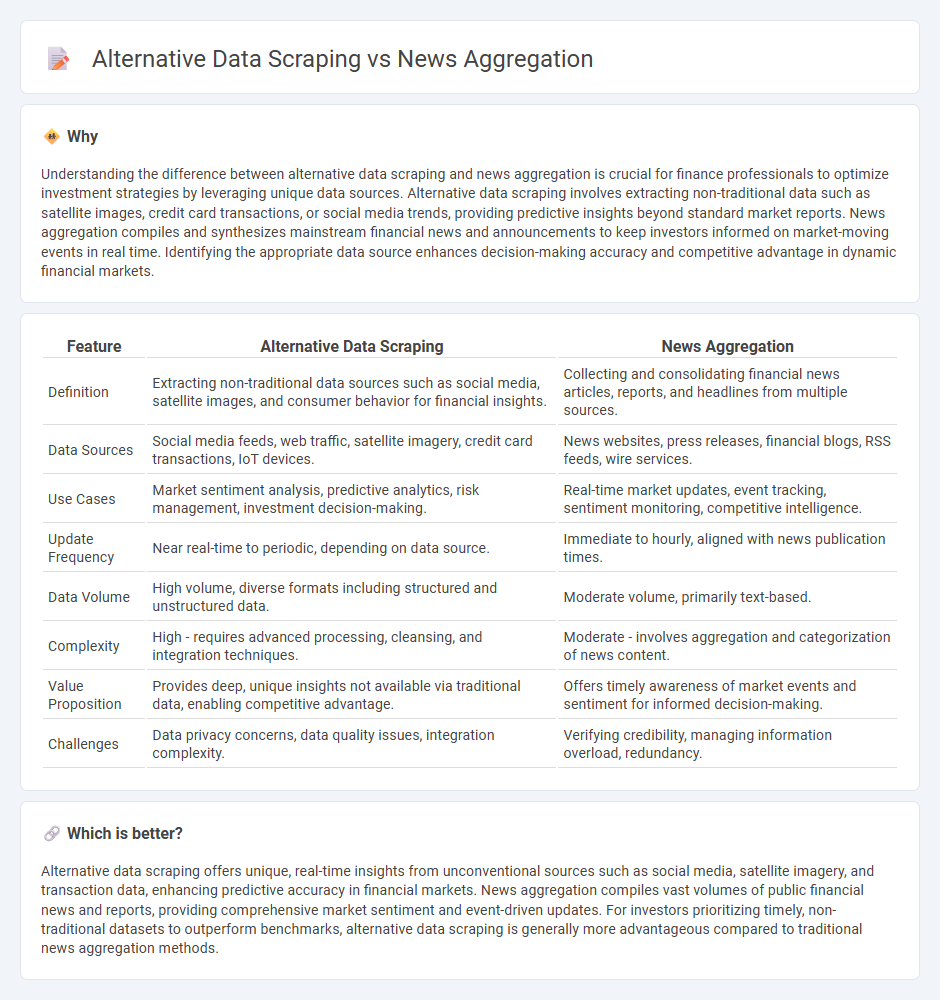
Alternative data scraping extracts unconventional datasets like satellite imagery, social media trends, and transaction records to uncover hidden financial insights. News aggregation collects and synthesizes real-time news articles, press releases, and market reports to provide comprehensive market sentiment analysis. Explore how these distinct methods enhance investment strategies and decision-making processes.
Why it is important
Understanding the difference between alternative data scraping and news aggregation is crucial for finance professionals to optimize investment strategies by leveraging unique data sources. Alternative data scraping involves extracting non-traditional data such as satellite images, credit card transactions, or social media trends, providing predictive insights beyond standard market reports. News aggregation compiles and synthesizes mainstream financial news and announcements to keep investors informed on market-moving events in real time. Identifying the appropriate data source enhances decision-making accuracy and competitive advantage in dynamic financial markets.
Comparison Table
| Feature | Alternative Data Scraping | News Aggregation |
|---|---|---|
| Definition | Extracting non-traditional data sources such as social media, satellite images, and consumer behavior for financial insights. | Collecting and consolidating financial news articles, reports, and headlines from multiple sources. |
| Data Sources | Social media feeds, web traffic, satellite imagery, credit card transactions, IoT devices. | News websites, press releases, financial blogs, RSS feeds, wire services. |
| Use Cases | Market sentiment analysis, predictive analytics, risk management, investment decision-making. | Real-time market updates, event tracking, sentiment monitoring, competitive intelligence. |
| Update Frequency | Near real-time to periodic, depending on data source. | Immediate to hourly, aligned with news publication times. |
| Data Volume | High volume, diverse formats including structured and unstructured data. | Moderate volume, primarily text-based. |
| Complexity | High - requires advanced processing, cleansing, and integration techniques. | Moderate - involves aggregation and categorization of news content. |
| Value Proposition | Provides deep, unique insights not available via traditional data, enabling competitive advantage. | Offers timely awareness of market events and sentiment for informed decision-making. |
| Challenges | Data privacy concerns, data quality issues, integration complexity. | Verifying credibility, managing information overload, redundancy. |
Which is better?
Alternative data scraping offers unique, real-time insights from unconventional sources such as social media, satellite imagery, and transaction data, enhancing predictive accuracy in financial markets. News aggregation compiles vast volumes of public financial news and reports, providing comprehensive market sentiment and event-driven updates. For investors prioritizing timely, non-traditional datasets to outperform benchmarks, alternative data scraping is generally more advantageous compared to traditional news aggregation methods.
Connection
Alternative data scraping collects non-traditional financial information from diverse sources such as social media, satellite images, and web traffic to provide unique market insights. News aggregation compiles real-time news articles and reports from multiple outlets, enriching datasets with up-to-date events and sentiment analysis. Integrating alternative data scraping with news aggregation enhances investment strategies by combining quantitative and qualitative inputs for comprehensive financial decision-making.
Key Terms
Data Sources
News aggregation platforms compile information from established media outlets, official press releases, and social media channels to provide comprehensive coverage on trending topics. Alternative data scraping involves extracting unconventional data sets such as satellite imagery, sensor data, web traffic analytics, and financial transactions to gain unique insights beyond traditional news sources. Explore further to understand how these distinct data sources impact decision-making and market analysis.
Real-time Updates
News aggregation collects and organizes real-time updates from various news sources to deliver timely information, enhancing decision-making for businesses and individuals. Alternative data scraping extracts diverse, non-traditional data from digital platforms, social media, and other unconventional sources for real-time market insights. Explore deeper distinctions and benefits by learning more about these dynamic data acquisition methods.
Sentiment Analysis
News aggregation collects and organizes headlines and articles from various sources to provide a comprehensive news overview, often used in sentiment analysis to gauge public opinion trends across established media outlets. Alternative data scraping extracts non-traditional datasets such as social media posts, user reviews, and forums, offering real-time insights into consumer sentiment and market behavior often missed by mainstream news. Explore how both methods enhance sentiment analysis accuracy and decision-making strategies.
Source and External Links
Top 8 Best News Aggregator Sites for Easy News Access - News aggregators collect and organize news from various sources into a single platform using algorithms, RSS feeds, or AI to streamline access and present diverse, relevant content tailored to user preferences.
Top 12 News Aggregator Websites for 2025 - News aggregator websites like Feedly, Inoreader, and Google News collect content via RSS feeds and other technologies to provide centralized access to multiple news sources, saving users time and effort.
News aggregator - Wikipedia - A news aggregator is software or a web application that gathers digital content such as newspapers, blogs, and podcasts in one place for easy viewing, often using automated algorithms to update and group related stories.
 dowidth.com
dowidth.com